A room contains more than one Martian. Each Martian has two hands, with at least one finger on each hand, and all Martians have the same number of fingers. Altogether there are between 200 and 300 Martian fingers in the room; if you knew the exact number, you could deduce the exact number of Martians. How many Martians are there, and how many fingers does each one have?
Oversight
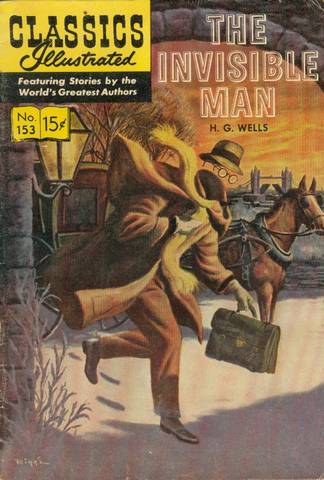
An invisible man would have transparent retinas — and thus be blind.
UPDATE: Wells seems to have thought of this! In Chapter XX, shortly after his transformation, the Invisible Man says:
“I struggled up. At first I was as incapable as a swathed infant — stepping with limbs I could not see. I was weak and very hungry. I went and stared at nothing in my shaving-glass, at nothing save where an attenuated pigment still remained behind the retina of my eyes, fainter than mist. I had to hang on to the table and press my forehead against the glass.”
In testing his cat, he had found that “there remained two little ghosts of her eyes … the back part of the eye, tough, iridescent stuff it is, wouldn’t go at all.” (Thanks, Nathaniel.)
Unquote
“If I could remember the names of all these particles I’d be a botanist.” — Enrico Fermi
Expertise
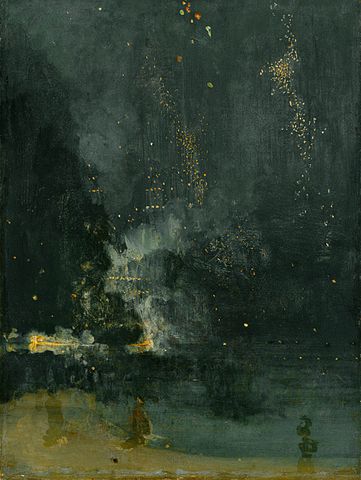
In 1877 James McNeill Whistler sued John Ruskin for panning his painting Nocturne in Black and Gold. “I have seen, and heard, much of Cockney impudence before now,” Ruskin had written, “but never expected to hear a coxcomb ask two hundred guineas for flinging a pot of paint in the public’s face.” The trial saw this exchange between Whistler and Ruskin’s attorney, Sir John Holker:
Holker: Did it take you much time to paint the Nocturne in Black and Gold? How soon did you knock it off?
Whistler: Oh, I “knock one off” possibly in a couple of days — one day to do the work and another to finish it.
Holker: The labour of two days is that for which you ask two hundred guineas?
Whistler: No, I ask it for the knowledge I have gained in the work of a lifetime.
Whistler won.
Similar: When Henry Ford’s engineers were unable to solve a problem with a huge new generator, he called Charles Steinmetz. Steinmetz listened to the generator for two days, made some calculations, mounted a ladder, and drew a chalk mark on its side. If the engineers would remove 16 windings from the field coil at that location, he said, the generator would work perfectly. He was right.
Afterward, Ford received a bill for $10,000. When he respectfully asked for an itemization, Steinmetz sent this:
Making chalk mark on generator: $1
Knowing where to make mark: $9,999
Total due: $10,000
On-the-Job Training

In the 1960s, biologist Karen Pryor was training two female rough-toothed dolphins to perform in a show at Hawaii’s Sea Life Park. Each dolphin had a different repertoire, and they were trained separately, though they could watch one another through a gate.
At one performance something was clearly wrong — each animal did everything she was asked to do, but with great agitation and sometimes in the wrong sequence. Pryor confessed her puzzlement to the audience and was pleased when the show concluded successfully. Afterward her assistant said, “Do you know what happened?”
“No.”
“We got the animals mixed up. Someone put Malia in Hou’s holding tank and Hou in Malia’s holding tank. They look so much alike now, I just never thought of that.”
Each dolphin had performed the other’s act, with no prior training, having only observed it in the earlier sessions. Hou had duplicated tricks that Malia herself had invented, an upside-down jump, a corkscrew, and coasting with her tail in the air, and Malia, wearing a blindfold, had retrieved three sinking rings in a sonar demonstration. Hou had jumped through a hoop held 6 feet above the water, a feat that normally requires weeks to train.
“I stopped the departing audience and told them what they had just seen,” Pryor wrote. “I’m not sure how many understood or believed it. I still hardly believe it myself.”
(From Pryor’s 1975 book Lads Before the Wind, quoted in Thomas I. White’s In Defense of Dolphins, 2007.)
No Connection
In 1816, enterprising meteorologist Francis Ronalds strung eight miles of wire through his London garden and created a working telegraph. When he offered it to the British Admiralty, he received this response:
Mr. Barrow presents his compliments to Mr. Ronalds, and acquaints him, with reference to his note of the 3rd inst., that telegraphs of any kind are now wholly unnecessary, and that no other than the one now in use [i.e., semaphore] will be adopted.
So Ronalds gave up. “I felt very little disappointment, and not a shadow of resentment, on the occasion, because every one knows that telegraphs have long been great bores at the Admiralty,” he wrote. “I claim no indulgence for mere chimeras and chimera framers, and I hope to escape the fate of being ranked in that unenviable class.”
A Caged Bird
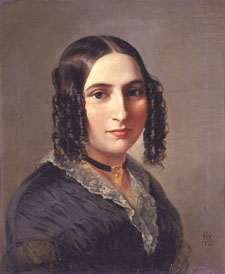
At least six of Felix Mendelssohn’s songs were written by his sister. Like Felix, Fanny Mendelssohn had trained as a child with Carl Friedrich Zelter, who wrote to Goethe in 1816 that she “could give you something of Sebastian Bach. This child is really something special.” But the bias of the times restricted a woman’s ambitions, and a lady of leisure could not be seen to pursue a profession publicly. Like the Brontës, George Sand, and George Eliot, Fanny found an outlet by publishing under a man’s name.
In an 1842 visit to Buckingham Palace, Mendelssohn found a copy of his Opus 8 songs on the piano in Queen Victoria’s sitting room. When he asked to hear her sing, she chose Fanny’s song Italien. Mendelssohn wrote to his mother, “After I had confessed that Fanny had written the song (which I found very hard, but pride goes before a fall) I begged her to sing one of my own works.”
Best-Laid Plans
Launched in November 1981, the Soviet Union’s Venera 14 probe carried a spring-loaded arm to test the soil of Venus.
The craft journeyed for four lonely months to reach its destination, descended safely through the hostile atmosphere, and landed securely on the surface.
The spring-loaded arm plunged downward — into a camera lens cap, which had just fallen there.
(Thanks, Merv.)
Fair Enough
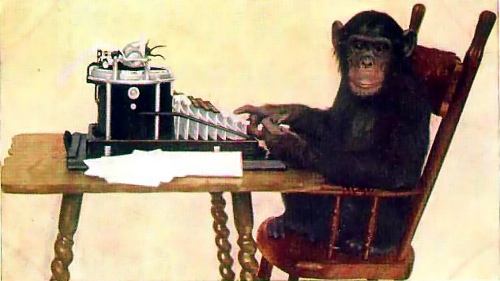
Apocryphal but entertaining: During one of Norbert Wiener’s talks on cybernetics, a student raised an esoteric point.
Wiener said, “Why, that’s as improbable as a bunch of monkeys having typed out the Encyclopaedia Britannica.”
The student said brightly, “But that’s happened once, anyway.”
Progress
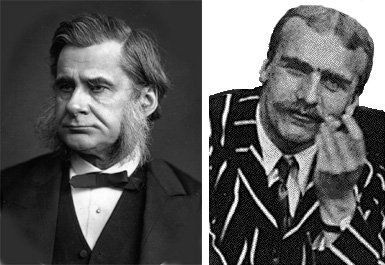
T.H. Huxley defined “four stages of public opinion” of a new scientific theory:
- Just after publication — The novelty is absurd and subversive of religion and morality. The propounder both fool and knave.
- 20 years later — The novelty is absolute truth and will yield a full and satisfactory explanation of things in general. The propounder man of sublime genius and perfect virtue.
- 40 years later — The novelty won’t explain things in general after all and therefore is a wretched failure. The propounder a very ordinary person advertised by a clique.
- A century later — The novelty is a mixture of truth and error. Explains as much as could reasonably be expected. The propounder worthy of all honour in spite of his share of human frailities, as one who has added to the permanent possessions of science.
J.B.S. Haldane had a more concise list:
- This is worthless nonsense.
- This is an interesting, but perverse, point of view.
- This is true, but quite unimportant.
- I always said so.
Louis Agassiz: “Every great scientific truth goes through three stages. First people say it conflicts with the Bible. Next they say it had been discovered before. Lastly they say they always believed it.”
